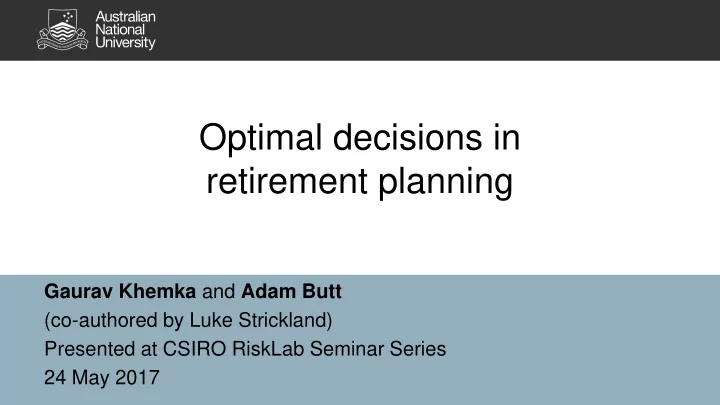

Optimal decisions in retirement planning Gaurav Khemka and Adam Butt (co-authored by Luke Strickland) Presented at CSIRO RiskLab Seminar Series 24 May 2017
Agenda • Introduction to lifetime financial modelling – Control variables – Utility theory • Our basic model – The effect of taxation – The effect of age pension • Next steps 2
A model of financial decision making 3
Control Variables • An individual has control of the following: – Asset allocation – Amounts to consume and save (given an income) – When and how to retire – Home purchase and sale – Etc. • We will be focussing on the first two in this presentation 4
A (very) brief introduction to stochastic dynamic programming • Financial objective ( V ) expressed as a function of control variables and stochastic assumptions • The expectation of the financial objective (E[ V ]) is maximized/minimized by selection of decision variables • Decision making is initially undertaken at the maximum age (109) across relevant state variables and then recursively for younger ages until age 25 5
Example – Constant Relative Risk Aversion Age 110 (final year) V 0 110 Age x <110 1 C q x x V max E 1 E V 1 q x x x x 1 x 1 2 6
What is Constant Relative Risk Aversion? 7
Basic Model Assumptions • Investment: Equity (ASX200) as risky asset and Government Bonds as defensive asset • Age Pension and Taxation: Rules as they stand (including changes already announced). • Individuals retire at age 65, earn $85,000 pre-tax income, get access to pension at age 65 • The only retirement product considered is account based pensions • Health states, mortality improvements are not allowed for • No allowances for home ownership, bequests, family status 8
Taxation Rules • Income tax (including 2% Medicare levy) • Concessional tax on super contributions and returns • Concessional Contribution limits • $1.6m pension cap • Minimum withdrawal limits 9
Pension Rules • Australian Pension rules – Income test – Asset Test • Assumes single, homeowner 10
Base Vs Tax rules – Consumption 11
Base Vs Tax rules – Asset Allocation 12
Base Vs Pension rules – Consumption 13
Base Vs Pension rules – Asset Allocation 14
Base Vs All rules – Consumption 15
Base Vs All rules – Asset Allocation 16
Base Vs All rules – Projection 17
Next Steps • Allow for pension access age of 67 and vary retirement ages to analyse outcomes • Make retirement a decision variable • Investigate alternative utility structures • Relax assumptions – Health states and mortality improvement – Family status – Home ownership, etc. 18
Recommend
More recommend